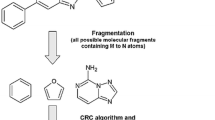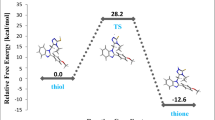Abstract
The chemical forces responsible for interaction of drug (HIV-1-NNRTI) with receptor (HIV-1-NNRTI-binding pocket) have been studied by evaluating log P and SASA for the measurement of hydrophobic interaction; energy of protonation (ΔE) for the measurement of most favorable hydrogen bond acceptor site; bond length and bond strain for the measurement of strength of hydrogen bond formed between drug and receptor; ΔE ‡ nm = ∣E ‡ n − E ‡ m ∣ for the measurement of polar interaction. The molecular modeling and geometry optimization of the compounds (drugs) and receptor amino acids (Val, Met, and Tyr) have been done using MOPAC-2002 associated with CAChe software. Softness Calculator has been used to evaluate effective atomic softness (E ‡ n and E ‡ m ). The results indicate that there is strong and effective hydrophobic interaction between hydrophobic substituent at site-6 of the drug and Val-Y187 of the receptor; hydrophobic substituent at site-5 and Met-Y184. Similarly, hydrogen bonds are formed between N-atom (site-6) of the drug and H-atom of the phenolic group of the Tyr-Y188; between phenolic group of the Tyr-181 and H-atom (site-1) of the drug. Polar interaction (charge transfer) occurs between –C=O/S (site-2) of the drug and –CONH– of Asn-Y182-Tyr-Y183.



Similar content being viewed by others
References
Ajay A, Murcko MA (1995) Computational methods to predict binding free energy in ligand-receptor complexes. J Med Chem 38(26):4953–4967. doi:10.1021/jm00026a001
Althaus IW, Chou JJ, Gonzales AJ, Deibel MR, Chou KC, Kezdy FJ, Romero DL, Thomas RC, Aristoff PA, Tarpley WG, Reusser F (1994) Kinetic studies with the non-nucleoside human immunodeficiency virus type-1 reverse transcriptase inhibitor U-90152E. Biochem Pharmacol 47(11):2017–2028. doi:10.1016/0006-2952(94)90077-9
Audry E, Dubost JP, Colleter JC, Dallet P (1986) Eur J Med Chem 21:71–72
Bodor N, Gabanyi Z, Wong CK (1989) A new method for the estimation of partition coefficient. J Am Chem Soc 111(11):3783–3786. doi:10.1021/ja00193a003
Clercq ED (1993) HIV-1-specific RT inhibitors: Highly selective inhibitors of human immunodeficiency virus type 1 that are specifically targeted at the viral reverse transcriptase. Med Res Rev 13(3):229–258. doi:10.1002/med.2610130303
Daniels DJ (1996) Surface-penetrating radar-IEE radar, sonar, navigation and avionics series 6, vol 320, The Institute of Electrical Engineers, London
Debnath AK (2005) Application of 3D-QSAR techniques in anti-HIV-1 drug design—an overview. Curr Pharm Des 11(24):3091–3110
Dewar MJS, Morita TF (1969) Ground states of conjugated molecules. XII. Improved calculations for compounds containing nitrogen or oxygen. J Am Chem Soc 91(4):796–802. doi:10.1021/ja01032a002
Fujita T, Iwasa J, Hansch C (1964) A new substituent constant, π, derived from partition coefficients. J Am Chem Soc 86(23):5175–5180. doi:10.1021/ja01077a028
Gruber C, Buss V (1989) Quantum-mechanically calculated properties for the development of quantitative structure activity relationships (QSAR, s). pKA-values of phenols and aromatic and aliphatic carbozylic acids. Chemosphere 19(10–11):1595–1609. doi:10.1016/0045-6535(89)90503-1
Horton HR, Moran LA Ochs RS Rawn JD Scrimgeour KG (1996) Principles of biochemistry, 2nd edn. Prentice Hall, Upper Saddle River, pp 36, 152
Horton HR, Moran LA, Ochs RS, Rawn JD, Scrimgeour KG (1996) Principles of biochemistry, 2nd edn. Prentice Hall, Upper Saddle River, pp 57–60
Huang DM, Chandler D (2000) Temperature and length scale dependence of hydrophobic effects and their possible implications for protein folding. Proc Natl Acad Sci USA 97:8324–8327
Kelly MD, Mancera RL (2005) A new method for estimating the importance of hydrophobic groups in the binding site of a protein. J Med Chem 48(4):1069–1078. doi:10.1021/jm049524q
Klopman G (1968) Chemical reactivity and the concept of charge-or frontier-controlled reactions. J Am Chem Soc 90(2):223–234. doi:10.1021/ja01004a002
Lee B, Richards FM (1971) The interpretation of protein structure: estimation of static accessibility. J Mol Biol 55(3):379–400. doi:10.1016/0022-2386(71)90324-X
Lum K, Chandler D, Weeks JD (1999) Hydrophobicity at small and large length scales. J Phys Chem B 103(22):4570–4577. doi:10.1021/jp984327m
Pauwels R, Andries K, Debyser Z, Kukla MJ, Schols D, Breslin HJ, Woestenborghs R, Desmyter J, Janssen PA (1994) New tetrahydroimidazo[4,5,1-jk][1,4]-benzodiazepin-2(1H)-one and–thione derivatives are potent inhibitors of human immunodeficiency virus type 1 replication and are synergistic with 2′,3′-dideoxynucleoside analogs. J Antimicrob Agents Chemother 38(12):2863–3870. doi:0066-4804/94$04.00+0
Pearson RG (1988a) Electronic spectra and chemical reactivity. J Am Chem Soc 110(7):2092–2097. doi:10.1021/ja00215a013
Pearson RG (1988b) Absolute electronegativity and hardness: application to inorganic chemistry. Inorg Chem 27(4):734–740. doi:10.1021/ic00277a030
Singh PP (1980) Bimetallic tetrathiocyanates and selenocyanates as lewis acids. Coord Chem Rev 32(1):33–65. doi:10.1016/S0010-8545(00)80369-0
Singh PP, Atreya K (1982) Studies on (SCN)2M(NCS)2Hg2(p-tolyl)2 and (SCN)2M(NCS)2Hg2(α-naphthyl)2 and their complexes. Polyhedron 1(9–10):711–722. doi:10.1016/S0277-5387(00)81055-4
Singh PP, Srivastava SK, Srivastava AK (1980) Matching between lewis acids and lewis bases on the basis of quantitative softness values and their relation with the stability of complexes-I. J Inorg Nucl Chem 42(4):521–532. doi:10.1016/0022-1902(80)80080-7
Singh PP, Pasha FA, Srivastava HK (2003) DFT based atomic softness and its application in site selectivity. QSAR & Combin Sci 22(8):843–851. doi:10.1002/qsar.200330828
Singh PP, Pasha FA, Srivastava HK (2004) Novel application of softness parameter for regeioselectivity and reaction mechanism. Indian J Chem B 43B(5):983–991
Singh PP, Pasha FA, Srivastava HK (2005) Semiempirical QSAR study and ligand–receptor interaction of estrogens. Mol Divers 9(1–3):215–220. doi:10.1007/s11030-005-2711-x
Trapani G, Carotti A, Franco M, Latrofa A, Genchi G, Liso G (1993) Structure–affinity relationships of some alkoxycarbonyl-2H-or-4H-pyrimido[2,1-b]benzothiazol-2-or-4-one benzodiazepine receptor ligands. Eur J Med Chem 28(1):13–21. doi:10.1016/0223-5235(93)90074-O
Author information
Authors and Affiliations
Corresponding author
Rights and permissions
About this article
Cite this article
Khan, A.K.R., Khan, S.A. & Ansari, M. Quantum chemical-based drug–receptor interaction of tetrahydroimidobenzodiazepinones (HIV-1-NNRTIs) with receptor (HIV-1-NNRTI-binding pocket). Med Chem Res 20, 231–238 (2011). https://doi.org/10.1007/s00044-010-9298-1
Received:
Accepted:
Published:
Issue Date:
DOI: https://doi.org/10.1007/s00044-010-9298-1




